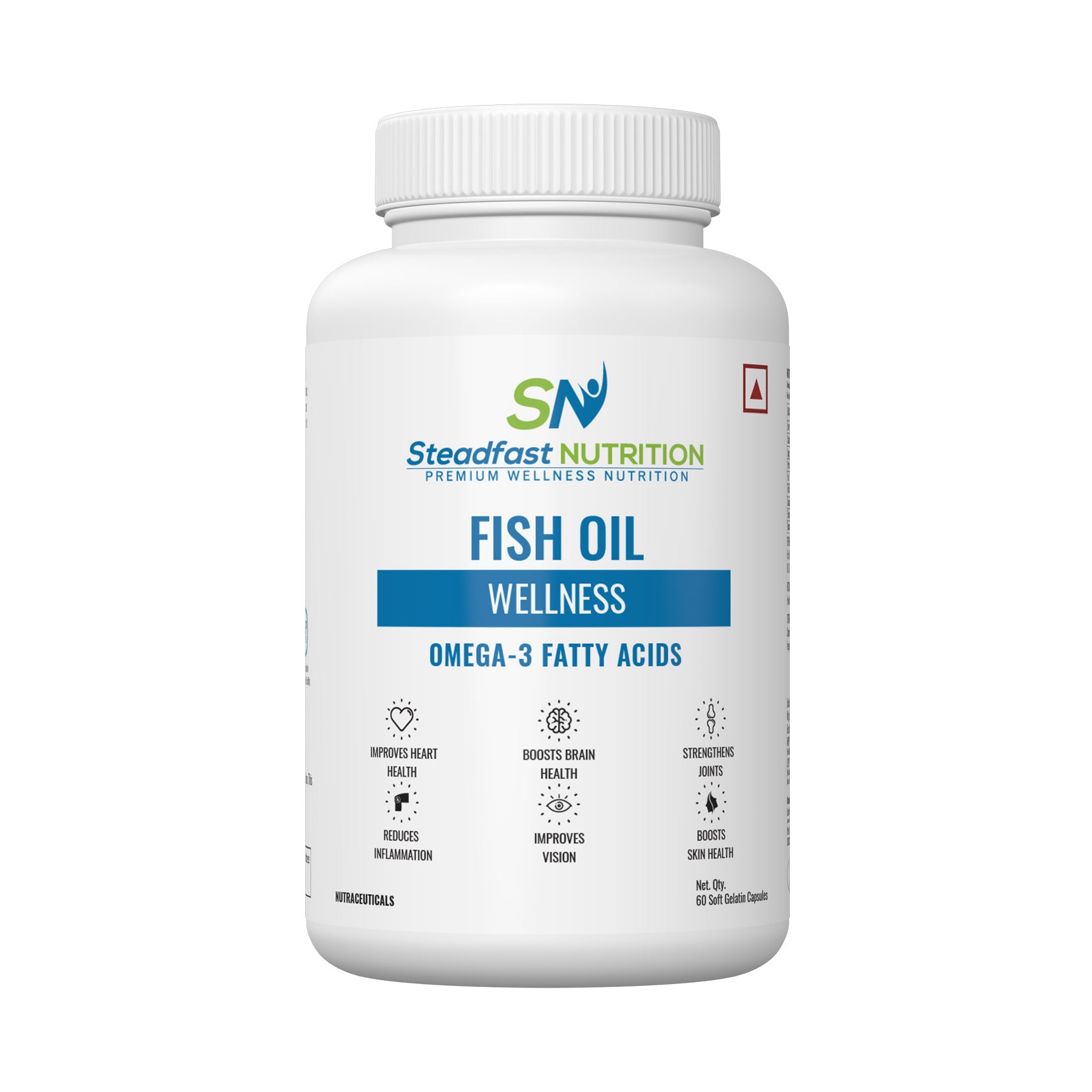
Fish oil is obtained from the tissues of oily fishes, containing omega 3 fatty acids in the form of eicosapentaenoic acid (EPA) and docosahexaenoic acid (DHA).
WHAT IS OMEGA 3 FATTY ACID?
Omega 3 is an essential fatty acid that is important for keeping up with good general health (Fish Oils, n.d.). This fatty acid cannot be synthesised in the human body, has to be consumed from outside source through diet and supplements. They are mostly found in oily fishes, certain nuts and seed oils.
Some types of Omega 3 fatty acid can reduce inflammation from arthritis. It may help relieve joint pain and stiffness in a similar way to non-steroidal anti-inflammatory drugs (NSAIDs).
Sources of Omega 3 fatty acids-
Omega 3 is found in both vegetarian and non-vegetarian sources. Vegetarian source contains omega 3 in the form of alpha-linolenic acid (ALA). ALA converts to DHA and EPA slowly only a small amount of it is converted to this form. Vegetarian sources include flax seeds, chia seeds, walnuts, tofu, canola oil, perilla seed oil, navy beans, Brussels sprouts, avocados. Non-vegetarian sources include salmon, shellfish ( mussels, oysters, clams), cold water fish (sardine).
Benefits of Omega 3:
The Facts on Omega-3 Fatty Acids(n.d.), states the benefits of omega 3:
- It lowers the elevated triglycerides level. Elevated triglycerides level leads to CVD.
- Best Omega 3 (EPA+DHA) can reduce stiffness and joint pain. It boosts the effectiveness of anti-inflammatory drugs.
- The high the levels of omega 3 lower the levels of depression. It also boosts the effects of antidepressants and may help the depressive symptoms of bipolar disorder.
- DHA is important for visual and neurological development in infants.
- It reduces the symptoms of ADHD ( Attention Deficit Hyperactivity Disorder), improves the mental skills, like thinking, remembering, and learning.
WHY OMEGA 3 IS IMPORTANT IN ARTHRITIS-
Treating arthritis with fish oil and omega-3(n.d.) says that the name “arthritis” is derived from two Greek words: “artho,” meaning “joint,” and “itis,”meaning “inflammation”. There are various kinds of arthritis and all of them affect the joints.
The most common is osteoarthritis. This one attacks the tough, flexible cartilage in and around the joint. It occurs mainly by wear-tear, osteoarthritis generally affects aged people. The second utmost form of arthritis is rheumatoid arthritis (RA). It is a chronic autoimmune disease that causes the immune system to attack the joint’s synovial capsule and other soft tissues.
Both types of arthritis causes inflammation and pain in joints.
Everything you need to know about Osteoarthritis(n.d.), says that when two bones come together they form a joint. Then the end of bones are covered with protective tissue called cartilage. In Osteoarthritis this cartilage breaks down, causing the bones within the joint to rub together. This leads to pain, stiffness, and other symptoms.
It occurs mostly in aged people, although it can occur in adults of any age. It is also called degenerative joint disease, degenerative arthritis, also wear and tear arthritis. The most commonly affected areas are hands, fingertips, knees, hips, spine(typically at the neck or lower back). Its symptoms include pain, tenderness (discomfort when pressing on the area with your fingers), stiffness, inflammation.
Everything you want to know about rheumatoid arthritis(n.d.) states that rheumatoid arthritis is an autoimmune disorder that may cause joint pain and damage throughout your body. Rheumatoid arthritis causes joint damage on both sides of the body. So, if a joint is affected in one of your arms or legs, the same joint in the other arm or leg will probably get affected. This is one manner that doctors distinguish rheumatoid arthritis from osteoarthritis. Buy Omega 3.
It is a long-term or chronic disease and its symptoms include joint pain, joint swelling, joint stiffness, loss of joint function. It can be treated by medications, dietary changes and specific types of exercises.
Required dosage of Omega 3
- According to FAO/WHO, 2008 RECOMMENDATIONS FOR DIETARY FATTY ACIDS (% total energy) of omega 3 for an adult man and woman should be in the range of AMDR 250-2000* mg/d.
- AMDR: accepted micronutrient dietary range
*including supplements (fish oil/ algal oil) for secondary prevention of CHD (to prevent the increased risk of lipid peroxidation and reduces cytokine production). (Indian Council of Medical Research,2010)
- The American Heart Association recommends 400-500mg of DHA/EPA per week( two servings of oily fish) for general health and wellness. Athletes should consider consuming 1gram of DHA/EPA three to four times daily, and endurance athletes should consider taking 5-10g/d based on their need. ( Bagchi et al.,2013)
Joint-friendly Fish oil:
“Can Omega 3 help joint health?” says that fish oil is a good source of generous doses of EPA (eicosapentaenoic acid) and DHA (docosahexaenoic acid), two essential fatty acids that have been shown to decrease inflammation in the joints. These essential acids are incorporated into cartilage cells where they decrease the enzymes that can degrade their flexible tissues with time. They increase blood flow, leaving your joints less prone to injury.
“Whats the best Omega 6 to Omega 3 ratio in food and supplement for knee arthritis says that Polyunsaturated fatty acid i.e Omega3 and Omega6 are essential for the health benefits they provide to our cells, brain, bones, skin, and heart for starters. These two acids are not self-producing by the body so they must be obtained from the diet. High level of Omega 3 intake results in less inflammation, but there’s a kicker with omega-6; high levels of omega-6 are associated with more inflammation in the body.
Simopoulos (2016) states that EPA and DHA changing the ratio of omega6 /omega3 i.e. increasing the intake of omega 3 inhibit the component which is responsible for joint pain.
Keeping the nutrient intake helps us stay healthy. So aim for healthy living with a balanced diet and added benefits of supplements.
References:
- Arthritis Australia(n.d.).Fish Oils.Retrieved from https://arthritisaustralia.com.au/managing-arthritis/living-with-arthritis/complementary-treatments-and-therapies/fish-oils/
- WebMD(n.d.).The Facts on Omega-3 Fatty Acids.Retrieved from https://www.webmd.com/healthy-aging/omega-3-fatty-acids-fact-sheet#1
- Bagchi, D., Nair, S., Sen, C.(2013).NUTRITION AND ENHANCED SPORTS PERFORMANCE MUSCLE BUILDING, ENDURANCE, AND STRENGTH(1st ed).India:Academic Press
- Nair, K.P.M., Augustine, L.F.(2018).Country-specific nutrient requirements & recommended dietary allowances for Indians: Current status & future directions.148(5),522-530
- Healthline(n.d.).Treating Arthritis with Fish Oil and Omega-3s (EPA and DHA).Retrieved from https://www.healthline.com/health/arthritis-fish-oil-omega-3
- Bare Biology(n.d.).The benefits of Omega 3 fish oil.Retrieved from https://www.barebiology.com/pages/guide-omega-3-fish-oil-joints-arthritis
- Simopoulos A. P. (2016). An Increase in the Omega-6/Omega-3 Fatty Acid Ratio Increases the Risk for Obesity. Nutrients, 8(3), 128. doi:10.3390/nu8030128
- CENTENO, C.(2018).Low Omega-6 to Omega-3 Ratio May Keep Knee Arthritis Pain in Check.Retrieved from https://www.regenexx.com/omega-6-to-omega-3-ratio-for-knee-arthritis-pain/
- Healthline(n.d.).Everything You Need to Know About Osteoarthritis.Retrieved from https://www.healthline.com/health/osteoarthritis#osteoarthritis-causes



 Buy Now
Buy Now



